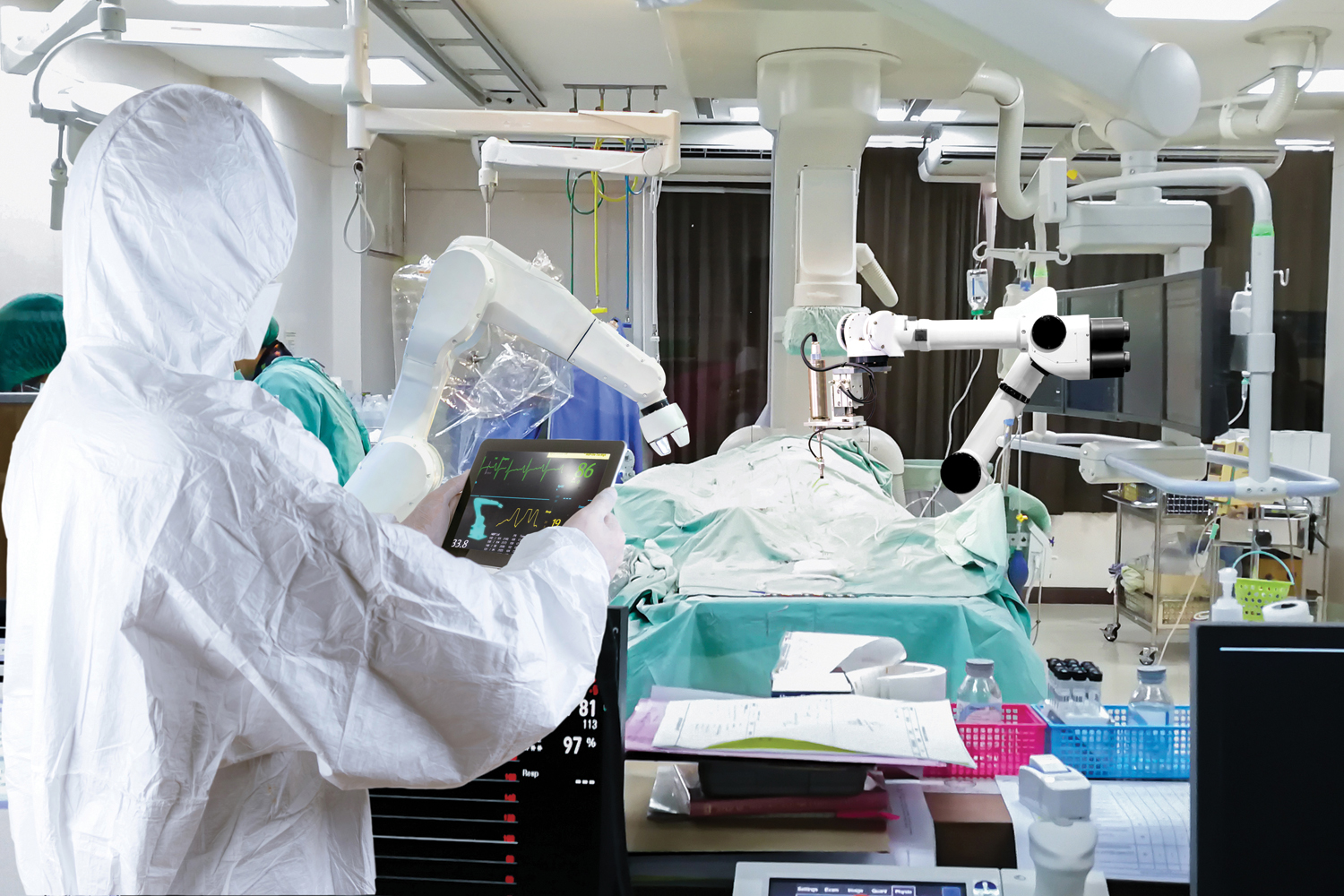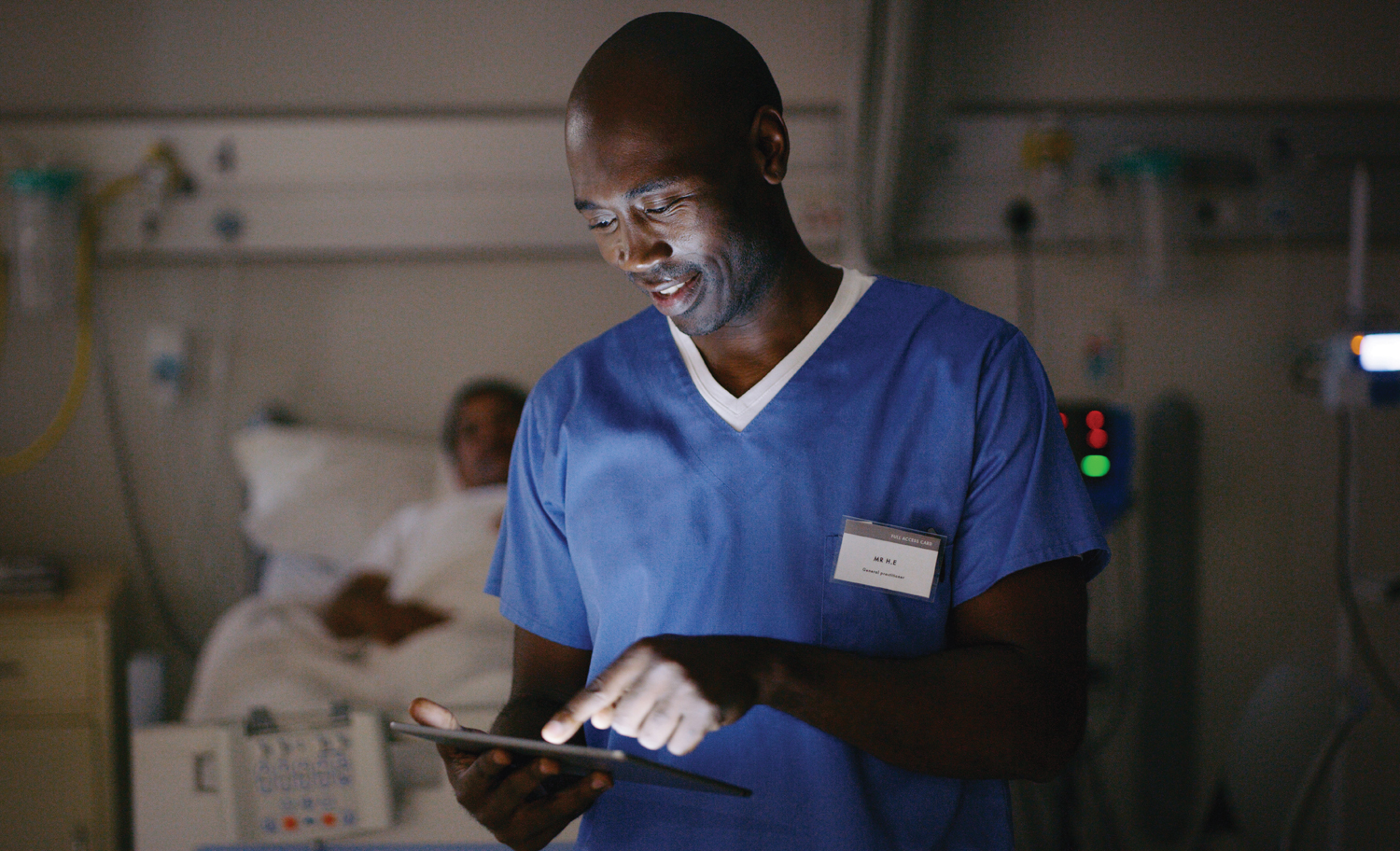
- Support portal
- Evaluation Kits and partner products
u-blox Support
- Product documentation
Documentation
- Investor relations
Investor relations
Squeezed for resources by the ongoing pandemic, hospitals are dialing up innovation to increase capacity.
Hospitals are full of contradictions. Within their walls, cutting edge CAT scanners coexist with archaic-looking orthopedic mallets and bone saws. Patients turn to them for recovery, while their often overworked staff burn the candle on both ends. They employ the world’s leading medical researchers, but are, when it comes to process, typically slow to innovate. They require highly aseptic spaces, yet they harbor some of the most resistant bacterial strains. And while their importance to human flourishing is generally recognized, their budgets are constantly under threat of being cut.
Even in normal times, hospitals operate under conditions of scarcity, in terms of medical personnel, money, space, and time. But, as should surprise no one, these are not normal times – especially not in hospitals. Confronted with a pandemic that defies comparison in our lifetimes, yet that experts have been warning about for decades, hospitals – like the healthcare sector as a whole – have been forced to grapple with a reckoning: they weren’t as prepared as they could have and, arguably, should have been.
This shock therapy is accelerating the move to digitalize healthcare that has slowly been building momentum since the advent of the modern computer in the 1960s. Pushed by multiple drivers including the aging population, the rise in non-communicable diseases caused largely by poor lifestyle choices, and financial constraints, and enabled by the rise of wireless sensing and communication and cloud storage and analytics, this digital transformation will profoundly impact who goes to hospitals, how hospitals operate, and even how they are built. Here are some of the most important trends we see emerging.
The benefits of remote care and telemedicine are well known. According to an analysis on virtual care by Deloitte, they can (i) improve clinical outcomes, (ii) enhance the patient experience, (iii) expand access to patients and clinicians, (iv) reallocate costs and improve efficiency, and (v) enhance care coordination, improving outcomes and saving billions. But it took the visceral fear of contracting a sometimes lethal virus to make them palatable to the broad public. In China, where the government launched the electronic medical insurance system, which covers virtually-delivered healthcare services to improve the efficiency of the healthcare system in 2019, remote consultations shot up 50-fold in the first month of the pandemic compared to one year prior. Meanwhile, US consumers also reported a marked shift in their willingness to use telehealth going forward, with eleven percent of those surveyed having used telehealth in 2019. Going forward, 76 percent are interested in adopting the technology.
This wholehearted embrace of virtual channels of communication marks an undeniable societal inflection point – one that will not easily be undone even when the level of alertness due to COVID-19 subsides. Accenture predicts that post-COVID, one in three consultations will be carried out virtually. These new channels will also be critical to implementing other eHealth solutions, transforming the relationship between patients and caregivers.
These include ambient assisted living solutions, which offer elderly individuals and those with special needs a “lifeline” they can rely on in an emergency, such as Leikr’s solution presented in the Partnership section of this magazine. Physiological monitoring using body-worn sensors can offer early warnings for neurological diseases, sleep issues, or other ailments that patients can address following their doctor’s recommendations. And remotely monitoring patients at home using connected biological sensors can free up much-needed hospital beds when demand surges.
We are used to seeing white-robed doctors and nurses roam hospital corridors. Robot assistants are still a relatively rare sight. But that, too, is changing, again driven by the pandemic-induced squeeze for resources. More and more robot helpers are stepping in to help with tasks they are able to carry out quicker, more safely, or with less whining than flesh and blood staff.
In a hospital in Antwerp, Belgium, patients suspected to have contracted COVID-19 were greeted and given a preliminary medical assessment by a robot who directed them to the department based on their symptoms. Similar robots were deployed elsewhere as well, such as in the Circolo Hospital in Italy, where patients could use the robots to interact with doctors via a touchscreen.
Disinfection of hospital rooms is another activity that is perfectly aligned with hospital robots’ skillsets. Companies such as Danish-based UVD Robots have developed a Wi-Fi-connected autonomous ground vehicle with a powerful UV-C ultraviolet light that can quickly and efficiently reduce the spread of viruses, bacteria, and other pathogens. Clinically tested and verified, the robots have logged extensive mileage in numerous hospitals around the world.
Other tasks that robots are being enlisted for include delivering food, medical supplies, and fresh bedsheets, with new use cases requiring more dexterity emerging as the robots gain in sophistication. Moxi, developed by Diligent Robotics, has an advanced robotic arm whose dexterity rivals that of humans, allowing it to collaborate on tasks otherwise reserved for humans. And drones, essentially robots with wings or rotors, saw their deployments soar during the pandemic, for instance delivering medical and commercial cargo in China’s Wuhan and Hebei Provinces and delivering patient samples to testing labs in Ghana.

It’s easy to lose track of patients, personnel, and equipment within a hospital’s labyrinthine floorplan. According to a 2018 survey by nursingtimes. net, nurses spend close to 40 hours each month tracking down equipment. The same survey suggests that around one time in six they fail to find what they were looking for. With medical personnel perpetually strapped for time, this is hardly a sustainable state of affairs.
That’s why more and more hospitals are turning to technology to keep tabs on people and things within their walls. While RFID tags are being used to automatically track inventories and ensure that supplies are replenished on time, Bluetooth-enabled real-time indoor location services are solving the problem for hospital staff, beds, and other mobile assets. Delivering accuracies from the room level (using standard Bluetooth beacons) down to sub-meter levels (using more recent Bluetooth direction-finding technology), these solutions leverage fixed antennas to display the location of tagged staff and equipment on digital maps of their premises.
By combining Bluetooth-based indoor location data with additional data sources, Finland-based Quuppa offers innovative ways to improve compliance for hygiene measures such as handwashing, as well as social distancing to reduce the spread of infections. As the technology becomes pervasive in the medical environment, new applications to increase patient safety, optimize process efficiency, and free up time for better care are bound to emerge.
Among the ongoing wave of technological innovation, electronic health records are likely to top the list in terms of their overall impact. Doctors’ patient records have traditionally been paper-based, often confined to a single site and, in keeping with the popular stereotype, impossible to decipher. While essential to monitoring the status of each patient in a specific case, assembling, processing, and storing patient records was time-consuming, error-prone, and insecure, resulting in patient data that was opaque, difficult to share, and tedious to learn from.
If meticulously managed, electronic health records, by contrast, make the totality of a patient’s medical history immediately accessible to their caregiver via a connected device, such as a computer, a tablet, or even a smartphone. The advantages of the approach become even more apparent when patients are transferred from one department within a hospital to another, or from one hospital to another one. Furthermore, should patients be willing to share their health records in an anonymized form for research, researchers can mine the data in search of clinically relevant insights into diseases.
Because of the highly sensitive information they contain, electronic health records have long been the grounds for privacy concerns – and rightly so, as there have already been several highly publicized leaks, some counting millions of records. For this reason, electronic health record databases are required to comply with locally applicable standards and regulations. Currently, these vary from region to region, again restricting their applicability.

The continuum of care, the distribution of labor, and logistical processes within hospitals are evolving to reflect the ongoing trend of digitalization at the same time as lessons from the ongoing pandemic are sinking in. In light of all this change, there’s no doubt that hospital buildings themselves will evolve as well. Pandemic facilities, already well established in Asian countries following their experience with the 2002-2004 SARS outbreak, are likely to become mainstream in hospital architecture, which will have to be made generally more flexible and adaptable to respond to outlier events such as the one we are currently living through.
“By dialing up innovation at all levels to improve efficiency with smartly leveraged technology, at least some of the scarcity could be alleviated.”
As the proportion of care delivered virtually increase, healthcare providers will find advantages in centralizing the reams of real-time digital information in command centers such as AdventHealth’s “Mission Control.” Bringing together data from across its network of patients and facilities, this command center lets them better optimize their scarce resources and improve the quality of care their patients receive. Such centers are likely to achieve similar goals within hospitals, for instance using GE Healthcare’s “Wall of Analytics.”
And while we’re accustomed to seeing helicopters take off and land on rooftop heliports, hospitals will likely need to upgrade their designs to include a drone port, in particular as these unmanned aerial vehicles take over a bigger chunk of logistical operations. And as we’ve seen earlier, tightly integrating this new technology into the inner workings of our hospitals could unleash an additional wave of technological and business model innovation in applications that go well beyond healthcare.
Ultimately, the current squeeze for resources does have a silver lining: hospitals, and the healthcare system as a whole, and being forced to step up their technological infrastructure. By dialing up innovation at all levels to improve efficiency with smartly leveraged technology, at least some of the scarcity – in particular that of time and money – could be alleviated.